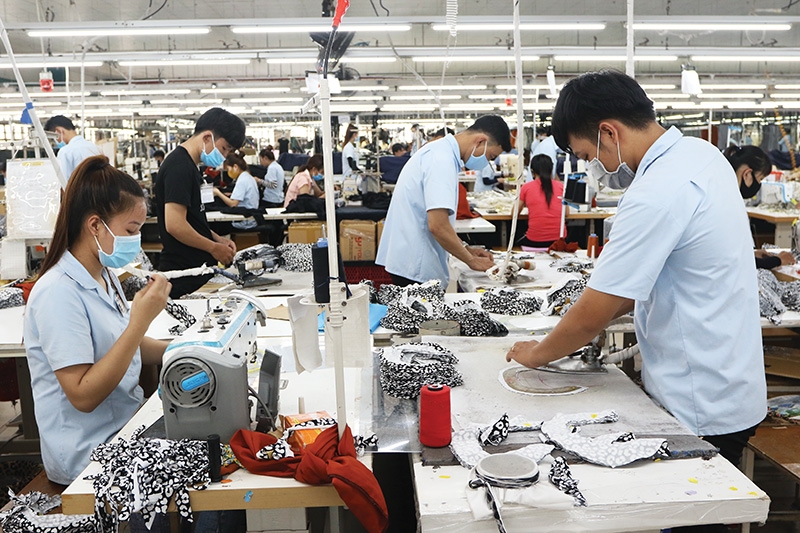Vietnamese labour market on right track for recovery
 |
| After a hefty hit in 2020, Vietnam’s labour market is slowly recovering, offering new jobs again. Photo: Le Toan |
In June, the Vietnamese labour market was shocked by the news that PouYuen Vietnam, a subsidiary of Pou Chen Group Taiwan, laid off nearly 2,800 employees due to the impact of COVID-19 as its orders dropped dramatically. The massive layoffs of shoemaker PouYuen Vietnam in Ho Chi Minh City started a series of many farewells between other businesses and their employees, most of which are footwear and textiles firms.
However, five months later, PouYuen Vietnam re-hired 2,000 office staff and assembly workers as new orders have increased by 50 per cent. Kim Vinh Cuong, vice president of PouYuen’s trade union, said that the newly-recruited employees at the end of 2020 are mostly working in the factory, with the rest working in office departments. This step has been seen by many labour experts as a signal marking the recovery of the labour market.
Massive recruitment numbers
From the beginning of the fourth quarter of last year, garment enterprises began to expand production and recruit more workers again as the number of orders from large markets like Europe has been gradually increasing.
With full order books until the end of March, CCH Top Co., Ltd. in Ho Chi Minh City is again focusing strongly on manufacturing hats meant for export, with more than 1,600 workers. The company has also recruited more than 100 workers since September, after having to lay off nearly 300 workers previously.
According to Tran Thi Ha Binh, senior director of Bowker Garment Co., Ltd., to overcome the most difficult period last year without having to lay off staff, the company began producing face masks and indoor sporting items as well as casual clothes.
“Currently, we are trying to stabilise production and open about 10 more lines to meet the demand. Moreover, we started deploying more machines and employed about 500-1,000 more workers in the first three months of 2021, striving to achieve a growth rate of about 5 per cent compared to 2020,” Binh explained.
Like every year, in the last two months of 2020 and the beginning of 2021, recruitment was higher as enterprises increase operation to serve the rising demand leading up to Lunar New Year.
In addition, the rapid recovery of the textile and garment industry, according to Navigos, also comes from Vietnam’s new policies and new-generation free trade agreements, leading to a wave of relocation from China to Vietnam. Some textile companies have registered or built new factories in Vietnam, mainly from China, Hong Kong, Taiwan, Japan, and Europe. With these new factories also comes a great recruitment demand for personnel in the next 3-6 months.
Meanwhile, the labour market in some other sectors is also warming up. Tran Viet Anh, chairman of Nam Thai Son Export Import JSC, said that since the end of last year, the company had to recruit 50 more employees to support the company’s business activities in 2021.
The recovery of the Vietnamese labour market in recent months has significantly contributed to the reduction of the unemployment rate. According to the General Statistics Office, unemployment in the second quarter of 2020 stood at 2.51 per cent, before falling to 2.29 per cent by the third and 2.16 per cent in the fourth quarter.
The average salary last year was VND6.62 million ($288) per month, a slight decrease compared to 2019, but still mostly considered a positive signal amid the pandemic as around 32.1 million workers lost their jobs or reduced their working hours.
More options
After six months as a freelancer since resigning from his old company in early January, Manh Thang from Cau Giay district went to the Hanoi Centre for Employee Services with the desire to find a job related to business and market development. Thang said that he hopes to find a new job at an electronics supermarket during the peak recruitment period. “Such a service job can be tough, but the salary is higher and shifts are more flexible. Plus, there are more options to choose from.”
Vu Quang Thanh, deputy director of the centre, said that Hanoi’s labour market is recovering as the number of enterprises registered to recruit in the past few months has risen, with some seeking hundreds of employees such as Canon Vietnam and Big C. Demand has increased sharply for office workers, service and sales personnel, construction consultants, and in real estate. It is expected that in the first quarter, recruitment demand will increase by 10-12 per cent, specifically in textiles, footwear, tourism, hospitality, and marketing. Jobs for unskilled workers may also increase by 5,000-7,000 positions, concentrated in sales and services.
However, recovery of the labour market still depends on the pandemic. “If the health crisis is controlled well soon, the number of people facing unemployment is likely to decrease every month, with the number of affected businesses decreasing by about 20-25 per cent,” Thanh said.
In Dong Nai province, 524 enterprises registered to recruit over 38,200 employees. In Binh Duong province, COVID-19 has caused more than 530,000 workers to become unemployed or take unpaid leave. But up to now, 7,865 enterprises have registered to recruit more than 146,700 positions.
It is expected that this year, Ho Chi Minh City will need an additional 280,000-300,000 employees. The demand comes mainly from businesses in trade, electronics and IT, services, and also in mechanics and automation.
| Vu Thi Thu Thuy - Director, Statistical Data Collection and IT Application Department, General Statistics Office
Employment and income of workers in Vietnam have been significantly affected by the pandemic, with some 32 million workers above the age of 15 years suffering in one way or another. The sectors that were affected the most include the service industry, construction, and agro-forestry-fishery. While in previous years the income of most employees continuously increased, in 2020 many had to see their wages decrease dramatically in comparison with last year. Over the past decade, 2020’s unemployment rate was the highest, and other indicators such as the underemployment rate also reached a record level. I do not know if the pandemic will return to Vietnam or not, but with suitable government policies, I believe business and production will flourish again. Support for workers can also come from job changes, additional skills training, and direct support in cash or other tangible goods. The government also offers practical support packages – however, access to these is still limited. Nevertheless, our office recommends to continue the implementation of such policies to ensure that workers have equal access to resources that can assist them in improving their employment and income. Nguyen Quoc Viet - General director, Dau Tieng Rubber Corporation
After last year, our company still faces many difficulties related to the coronavirus pandemic and unfavourable weather conditions, causing rubber prices to plummet. However, the number of employees at the company remained stable, with more than 4,700 people currently in work. Although there are no plans to recruit more people, we are planning to improve labour productivity and increase welfare for workers, especially those with higher skills and a long time in the company. We hope that by doing so, we will create a dynamic, healthy, and competitive work environment so that employees can maximise their capabilities. In the current context, keeping the number of employees stable is our top goal. But in following our long-term development plan, the company will eventually hire more qualified and long-term workers, depending on the production needs. Nguyen Duy Ninh - Project director, Ho Guom Group JSC
Along with us, many other garment enterprises had to lay off a series of workers in the first half of 2020. Although vaccines have started to be rolled out, the pandemic remains very complicated in many of Vietnam’s main export markets like the United States and Europe. So, I think that although there are signs of slow recovery, the demand for long-term employment of enterprises is not high; and even though the labour market is prosperous, it consists mainly of jobs for seasonal workers. This new year will most likely continue to be a very difficult one, maybe even tougher than 2020. Thus, our goal is to continue to maintain the current number of employees and find more solutions to encourage them to improve productivity and efficiency; from there, we hope to gain enough resources to turn up production as soon as the disease is under control. |
What the stars mean:
★ Poor ★ ★ Promising ★★★ Good ★★★★ Very good ★★★★★ Exceptional
Themes: Human Capital 4.0
Related Contents
Latest News
More News
- Vietnam bucking trend in the global M&A landscape (December 16, 2025 | 14:20)
- Vietnam’s green transition demands collective financial action (December 15, 2025 | 12:00)
- VIR workshop highlights capital and policy for sustainable development (December 15, 2025 | 11:00)
- National Assembly approves pilot mechanisms to accelerate major projects in Hanoi (December 12, 2025 | 11:29)
- Vietnam eases policy approval requirements, simplifies foreign and outbound investments (December 11, 2025 | 17:53)
- Unpacking new momentum in Vietnam’s M&A market (December 10, 2025 | 09:59)
- Forum honours outstanding M&A deals, strategies, and advisory firms (December 09, 2025 | 18:22)
- Vietnam enters defining phase of M&A growth (December 09, 2025 | 17:00)
- Vietnam’s M&A market opens new opportunities amid strong economic momentum (December 09, 2025 | 15:00)
- Vietnam M&A Forum 2025: new position, new momentum (December 09, 2025 | 14:30)




 Tag:
Tag:






















 Mobile Version
Mobile Version